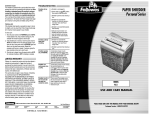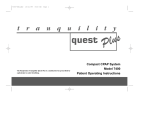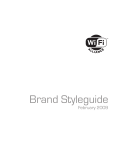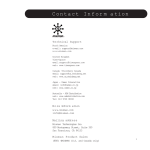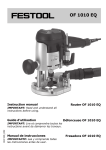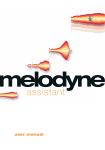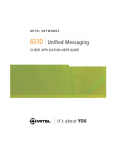Download Auto CPAP System Model 7410 Patient Operating Instructions
Transcript
7410-00C.QXD 10/1/99 7:40 AM Page 1 Auto CPA P System Model 7410 Patient Operating Instructions The Respironics Tranquility Auto is a medical device prescribed by a physician to assist breathing. 7410-00C.QXD 10/1/99 7:40 AM Page 2 Table of Contents User/Owner Responsibility................................................................................................... 2 Scope of this Manual ....................................................................................................... 2 Introduction .............................................................................................................. 2-3 W arnings and Cautions...................................................................................................... 3-4 Set-up and Use ............................................................................................................ 5-9 Unpacking and Inspection ........................................................................................... 5 Initial Use ....................................................................................................... 6-8 Routine Use ..................................................................................................... 8-9 Humidifier ...................................................................................................... 9 Using Oxygen with this System....................................................................................... 9 AC Fuse ............................................................................................................... 10 Traveling with your APAP System ............................................................................................. 10 DC Operation ............................................................................................................. 10 Altitude Compensation ...................................................................................................... 11 Maintenance.............................................................................................................. 11 Changing the Filter ................................................................................................ 11 Cleaning the System ............................................................................................... 11 Routine Maintenance............................................................................................... 11 Troubleshooting Guide ...................................................................................................... 12-13 Maintenance Record........................................................................................................ 14 Patient Checklist .......................................................................................................... 15 Annual Inspection ......................................................................................................... 15 Glossary ............................................................................................................... 16 Specifications ............................................................................................................. 17 Classification ............................................................................................................. 17 Storage and Transport....................................................................................................... 18 Operating ............................................................................................................... 18 Electromagnetic Compatibility ................................................................................................ 18 Accessories .............................................................................................................. 19 7410-00C.QXD 10/1/99 7:40 AM Page 3 Glossary of Symbols Symbol Description Attention, consult accompanying documents (such as, manuals). Read thoroughly and understand this manual before attempting to use this APAP™ system. Power switch Off (Disconnection from the mains) Power switch On (Connection to the mains) ~ Alternating current Ramp Class II equipment (Double insulated) IPX1 Protected against vertically falling water Type BF applied part 1 7410-00C.QXD 10/1/99 7:40 AM Page 4 User/Owner Responsibility This Respironics APAP™ (Automatic Positive Airway Pressure) system and authorized accessories are designed to work as described in this manual. You should not use parts that have failed, exhibit excessive wear, are contaminated, damaged or otherwise ineffective. Read this entire manual before using this APAP system. The user/owner of this system shall have the sole responsibility and liability for any injury to persons or damage to property (including this equipment) resulting from: 1. Operation not in accordance with supplied operating instructions; 2. Maintenance not in accordance with authorized maintenance instructions; 3. Maintenance by anyone other than a factory-authorized service representative; 4. Modification of the system or accessories; or 5. Use of damaged or unauthorized components or accessories. The Scope of this Manual This manual will show you how to operate the Respironics Tranquility® Auto Model 7410 nasal APAP system to provide positive pressure to the breathing passages. Read thoroughly and understand this manual before attempting to use this system. Introduction Nasal CPAP devices produce small amounts of air pressure that is delivered using a nasal mask. This pressure opens the breathing passages to prevent blockages and to allow normal breathing. The Tranquility Auto system provides various levels of pressure. The pressure delivered at any time is based on your needs. The APAP system makes repeated measurements and tests of air flow and pressure to provide automatic adjustment of the therapy. The pressure is controlled by a microprocessor that monitors flow and a pressure transducer to provide accuracy and comfort and adjust to changes in elevation The Tranquility Auto (Model 7410) system from Respironics, is a medical device that includes a microprocessor. The microprocessor 2 7410-00C.QXD 10/1/99 7:40 AM Page 5 receives information from a flow sensor and pressure transducer and processes this information in order to adjust the blower to deliver the pressure that you require. Additionally, this compact unit features an initial ramp, a convenient handle and an easily replaceable or washable filter. Warnings and Cautions W ARNING-indicates a potentially harmful situation 1. This is an automatic positive airway pressure device and is intended be used in the treatment of adult obstructive sleep apnea. 2. Do not use this APAP unit in the presence of flammable anesthetics. 3. Do not use the APAP unit around water in any way, except for water contained in a Respironics Humidifier. 4. If this unit should come in contact with water, unplug the unit. 5. This unit should never be turned on and left unattended. 6. Never operate this unit if the power cord or plug is damaged. 7. If this unit has been dropped or damaged, contact your distributor or Respironics at once. 8. Adjusting the pressure without a physician's instruction could be harmful. 9. The APAP device should only be used with a nasal interface or mask and patient circuit that are supplied by Respironics. Never, under any circumstances, use the nasal interface or patient circuit unless the Tranquility Auto is turned on and operating properly. 10. Do not block or obstruct the vent hole located on the front of the nasal mask or interface. 11. Make sure that all breathing connections are properly secured. 12. For 12 VDC operation, do not use any DC to AC inverter other than that supplied or recommended by Respironics. 13. Check and verify fuse rating before replacement. 14. When using supplemental oxygen with this system, make sure that this APAP system is switched on before the oxygen source is turned on. When you wish to stop using this APAP system, turn off the oxygen flow first before turning this APAP unit off . 3 7410-00C.QXD 10/1/99 7:40 AM Page 6 15. Oxygen quickly accelerates fire. If you are using supplemental oxygen, this APAP system as well as the oxygen source must be kept away from heat or open flame. Smoking in the area of use must not occur. 16. As with any electrical device, do not use this APAP unit during an electrical storm. 17. Do not use this APAP unit with a portable electrical generator. CAUTION-indicates a condition that may lead to equipment damage, malfunction, or inaccurate operation. 1. Do not use a room humidifier within six feet of this unit. Dampness may affect device parts. 2. Do not use attachments that are not recommended by Respironics. 3. This APAP system is to be used in the manner described in this manual. 4. Never drop or insert any objects into the connecting hose or air outlets or inlets. 5. Operating the unit with a dirty filter may keep the APAP unit from working properly. 6. Do not use extension cords or electrical adapters. 7. At low pressures, the flow through the exhalation port may not be enough to clear all of the exhaled gases from the hose. As a result, you may breathe in some of the air that you have breathed out. 8. Do not sterilize this unit. 9. Be aware that interference with the operation of this device can occur from external sources. Even though this device contains methods and techniques that can provide protection from external sources of interference, you should take the following precaution: Keep the device at least three feet away from all electrical appliances such as T V sets, electric blankets, air conditioners, cordless telephones and cellular telephones. 10. The airflow for breathing produced by the APAP can be as much as 1.8°F (1.0°C) higher than the temperature of the room. Exercise caution if the room temperature is warmer than 90°F (32°C). CAUTION:FEDERAL L AW RESTRICTS THIS DEVICE TO SALE BY, OR ON THE ORDER OF,A LICENSED PHYSICIAN. THIS A PA P UNIT SHOULD BE USED ONLY UNDER THE SUPERVISION OF A LICENSED PHYSICIAN. 4 7410-00C.QXD 10/1/99 7:40 AM Page 7 Set-up and Use Unpacking and Inspection When you get your APAP system, carefully open the box and unpack the system, making sure that you have the following components and that nothing appears to be damaged. Accessories are not included in this basic package and can be ordered separately. Included with this system is the following: 1. Tranquility Auto (Model 7410) nasal APAP unit 2. AC Power Cord 3. Six-foot Hose 4. Carrying Case 5. Patient Operating Instructions 5 You will need a Nasal Interface (Nasal Mask or other type of interface) in order to use this system. IF A N Y O F THESE COMPONENTS ARE MISSING OR DAMAGED, CONTA C T RESPIRONICS AT ONCE. 5 7410-00C.QXD 10/1/99 7:40 AM Page 8 Initial Use 1. Before each use, inspect this unit for any signs of damage, failure or worn parts. Contact Respironics or your Home Care Dealer immediately to replace these parts. Also check to see if there is any moisture in the area of this APAP unit and check the air inlets and outlets for any blockage or the presence of any dust or dirt. If you find moisture, dry the area thoroughly before use. Remove any blockage and/or dust or dirt from the air inlets or outlets before each use. Do not use a room humidifier within six feet of this APAP unit. 2. Place the APAP unit in a clean, dry place near an electrical outlet not controlled by a wall switch. Do not use extension cords or electrical adapters. Place this unit in an upright position on a nightstand or other suitable surface with the front facing you. Position this APAP unit so that the vents are never blocked. Never allow the APAP unit to be placed on a table or nightstand that cannot safely support the APAP unit. For example, do not use a table or nightstand without good support that will turn over if it is accidentally bumped. 3. Connect the power cord to the AC power connector on the rear of the unit. After checking to be sure that the Power switch is in the OFF position, plug the other end of the power cord into the electrical outlet. 6 7410-00C.QXD 10/1/99 7:40 AM Page 9 4. Attach the APAP Hose to the Air Outlet Port on the front of the APAP unit. 5. Attach the Nasal Mask to the other end of the APAP Hose. 6. Refer to the Nasal Mask Instruction for information on preparing the interface and making adjustments. Do not block the hole (bias flow port) located at the base of the Mask. 7. Turn the APAP unit on using the Power switch located on the front of the unit. This unit cause air to begin flowing through the hose, and mask. Power 8. Place the Nasal Mask on and adjust it to get rid of any leaks while maintaining comfort. The pressure that you are receiving should allow you to locate and eliminate most leaks. 9. As you breathe in, you will find that the airflow will increase slightly. The unit's pressure controller adjusts to constantly deliver the set pressure. 7 Ramp 7410-00C.QXD 10/1/99 7:40 AM Page 10 10. The Ramp button on the front of the APAP unit may be used to reduce the pressure to a lower level so that you go to sleep easier.If your physician has prescribed a higher starting pressure then you may not notice a reduction in pressure when pressing the ramp button. After the pressure is reduced it will slowly increase to higher level over a fifteen minute period. At the end of this period the APAP unit will sense your breathing and change the pressure to meet your needs. 11. You may press the Ramp button at a latter time to start a new ramp. 12. In the morning or whenever you wish to stop using the unit you can switch the unit off by switching the Power switch to the OFF position and removing the Nasal Mask. Routine Use Regular use of the Tranquility Auto System involves a simple, brief routine that is detailed here. 1. Switch the Power switch to the ON position. The Power indicator light will come on. Airflow will be felt coming out of the hose and mask. The pressure will increase to a level that can be used to check your mask for leaks. 2. Place the Nasal Mask, with the Headgear and Hose attached, on and adjust the Headgear straps as needed. Check the mask for any leaks and adjust as needed. 3. You may now press the Ramp button to reduce the pressure as you fall asleep. If you do not wish to reduce the pressure you may keep the pressure at this level until the APAP unit begins to seek the pressure that you need. 4. If the Hose becomes disconnected from either the Nasal Mask or the APAP unit, the unit may go into a Flow Limit mode. In this mode the pressure will be lowered to prevent any damage to the unit. When the connection is reestablished, the pressure will return to the level set by the Home Care Dealer. 5. If you need to get up during the night, turn the Power switch to the OFF position and remove the Mask. When you wish to start using the APAP unit again, replace the Nasal Interface and Headgear and turn the unit ON. Make sure to check for leaks as you have done previously. If you wake up, you may press the Ramp button to lower the pressure. 6. In the morning or when you are through using the unit, turn the Power switch OFF and remove the Mask. 7. The nasal mask, headgear, and hose should be removed from the system for cleaning. 8 7410-00C.QXD 10/1/99 7:40 AM Page 11 Humidifier Use An optional Humidifier is available through Respironics for use with the system. The Humidifier is a reservoir that fits under your unit. When properly filled with distilled water, it adds moisture to the airflow and reduces nasal dryness and irritation. Do not leave water in the Humidifier when the hose is disconnected. Small amounts of water may be blown out of the Humidifier if the blower accidentally comes on. Follow the instructions included with the Humidifier regarding cleaning. C O N TACT YOUR DEALER FOR FURTHER INFORMATION. Using Oxygen W ith This System It is important that you read, understand and carefully follow these instructions regarding the use of oxygen with your Tranquility Auto system. CAUTION: Oxygen is a prescription gas and should be used only under the supervision/direction of a licensed physician. While using oxygen, the APAP system and oxygen source must be kept away from heat and open flame. Smoking by anyone in the presence of oxygen must not occur. 1. Set-up Attach the oxygen tubing to the hose using the loops included with the Oxygen Administration Kit. Thread the oxygen tubing through the holes in the loops. Attach the T-adapter between the mask and the hose. Attach one end of the tubing to the T-adapter and the other end to the oxygen source. 2. Oxygen Use Turn on the APAP unit so that air flow will begin before turning on the flow of oxygen. When turning the APAP unit off, always turn the oxygen flow off first and then the APAP unit. NEVER TURN THE A PA P UNIT ON OR OFF WITH OXYGEN FLOWING INTO THE UNIT. 9 7410-00C.QXD 10/1/99 7:40 AM Page 12 AC Fuse Ifthe APAP unit's power indicator does not light up when the unit is plugged in and turned on, the fuse may need to be replaced. When replacing the fuse, make sure that the power cord is not plugged into the electrical outlet. Remove the power cord from the receptacle on the rear of the unit. Remove the fuse holder by pressing the two tabs together and pulling out. The fuse must be replaced with an identically rated fuse. The correct fuse is a T1AL, 250V,(1 Amp, 5mm x 20mm, 250 Volt Slo-Blo). After replacing the fuses in the fuse holder, press the holder back into the receptacle and replace the power cord. Traveling With Your APAP System The Tranquility Auto will operate on a range of voltages from 100 VAC to 240 VAC and on 50 or 60 cycles. You do not need to switch from one voltage setting to another.You will need to use a plug adapter in some locations in order to connect the power cord into the available wall outlet. When traveling by airplane, do not check your APAP system as baggage because it may be damaged. Always carry this manual with your APAP system when you travel, both for reference and for the notice that this is a medical device that requires regular use. This notice may be helpful in dealing with Customs agents. DC Operation Operating the APAP system from a DC power source will require the use of a Respironics DC to AC Inverter (Part Number 7304). When connecting the DC to AC Inverter, turn the APAP system Power switch OFF. Connect the AC power cord to the AC receptacle of the Inverter. Then, plug the DC to AC Inverter into a cigarette lighter-type connector as found in cars, trucks, boats, etc. Under normal conditions, this unit will typically draw less than 3 amperes. The maximum draw for the inverter is listed in the DC to AC Inverter manual. For 10 hours of DC to AC Inverter use, this unit will typically consume less than 30 Amp hours. 10 7410-00C.QXD 10/1/99 7:40 AM Page 13 Altitude Compensation The Tranquility Auto unit features a pressure transducer that measures pressure delivered to you and a microprocessor that makes the needed adjustments if you travel to a different elevation. The unit will automatically adjust the blower speed to compensate for the new elevation and deliver the prescribed pressures. The Tranquility Auto operation that continually measures airflow, automatically adjusts therapy as you travel to different elevations. Maintenance Changing the Filter The Tranquility Auto is supplied with a reusable filter.This filter can be removed from the rear of the unit by pulling it directly out of the filter receptacle. The filter should be washed thoroughly with a mild soap and water solution, rinsed thoroughly with clear water and allowed to dry completely before use. Return the filter to the unit by pressing it against the filter receptacle and tucking the edges into place. An optional disposable filter is available for removal of smaller particles. Check the condition of the filter prior to each use. Cleaning The System The APAP unit should be cleaned using a cloth moistened with water and a mild soap solution. Caution: Unplug the unit before cleaning it. Do not place the unit in water. Do not use alcohol or other organic solvents to clean this unit. Let the unit dry completely before plugging it in or operating it. Routine Maintenance Other than the cleaning detailed above, no other maintenance is required by the user.NOTE: You should not attempt to open the unit's enclosure; there are no user serviceable components inside. Unauthorized tampering with the unit's enclosure or unauthorized servicing will void the warranty and could result in damage and or personal injury. 11 7410-00C.QXD 10/1/99 7:40 AM Page 14 Troubleshooting Guide PROBLEM POSSIBLE CAUSES INSTRUCTIONS 1. Unit not connected to live power source Check to see if unit is plugged into a live power source Fuse needs to be replaced Contact your dealer for a new fuse Incorrect fuse was used Contact your dealer for a new fuse Filter may be blocked by debris W ash or replace filter Internal component has failed Contact your dealer Filter may be blocked by debris W ash or replace filter Inlet vent may be blocked Move the device away from the source of blockage Room air temperature has increased Reduce room air temperature Leak in the system Verify that the mask is not allowing air to leak and that there are no leaks in the hose. (Pressure check at zero flow) Filter may be clogged W ash or replace the filter Internal component has failed Contact your dealer Ramp is active Turn power OFF and then ON to deactivate ramp 2. 3. 4. Unit does not turn on No air comes out of device when it is turned on Air from device seems warm Feeling that the pressure is too high or too low 12 7410-00C.QXD 10/1/99 7:40 AM Page 15 PROBLEM POSSIBLE CAUSES INSTRUCTIONS 5. Pressure from the APAP unit While APAP may provide lower and more comfortable pressure an initial period of adjustment of up to two-three weeks, may be required. Relax and take slow deep breaths. If discomfort continues after two to three days, contact you physician. Mask is not fitting properly Try again to fit the mask to your face. If leaks continue, contact your dealer W rong size nasal mask Contact your dealer Headgear too tight Readjust the headgear W rong size nasal mask Contact your dealer General irritation or allergic reaction to the mask material Discontinue use and notify your physician Feelings of discomfort from the sensation of too much pressure 6. Air leaks around the nasal mask irritating the eyes 7. Skin becomes red where mask touches skin 8. Runny nose Reaction to air flow Discontinue use and notify your physician 9. Dryness of throat or nose Inadequate humidity Increase humidity or contact physician regarding the use of a humidifier 10. Nasal, sinus, or ear pain Sinus infection or middle ear infection Discontinue use and notify your physician 11. Return of original symptoms APAP unit is not responding Have your dealer verify the proper operation of the APAP unit 13 7410-00C.QXD 10/1/99 7:40 AM Page 16 Maintenance Record Dates Notes Replaced Nasal Mask / / / / / / / / / / Replaced Headgear / / / / / / / / / / Replaced Hose / / / / / / / / / / Replaced Filter / / / / / / / / / / Checked APAP Pressure / / / / / / / / / / 14 7410-00C.QXD 10/1/99 7:40 AM Page 17 Patient Checklist As you and your Home Care Dealer go through the operation of your APAP system, make sure that you thoroughly understand the following: Why your physician has prescribed the APAP system. The importance of using your APAP System each and every night. How to properly connect the Hose to the device and to the Nasal Mask. How to put on the Nasal Mask and Headgear to achieve a good fit. The importance of not blocking the Inlet Vent on the APAP unit. How to operate the Ramp feature. How to care for the Nasal Mask, Headgear, and Hose. How to clean and/or replace the filter. How to check the operation of the nasal APAP unit. What to do if symptoms of obstructive sleep apnea reappear. What to do if you experience any ear, nose or sinus pain. Annual Inspection It is recommended that a routine inspection of the nasal APAP system be performed at least once each year. This service should include: 1. Visually inspecting for any damage; 2. Replacing the filter; 3. Verifying the pressure setting; 4. Checking the condition of the Mask and Headgear. ** Contact your authorized dealer for further information ** 15 7410-00C.QXD 10/1/99 7:40 AM Page 18 Glossary of Terms W ords in this glossary are italicized in their first use in the manual. Anesthetics A drug that is used to control pain. APAP A device that is used to treat obstructive sleep apnea with air pressure that changes to meet changing needs. Flow Sensor A device located in the Tranquility Auto that measures the movement of air as it leaves the device. Humidifier A device that can be used with the Tranquility Auto to add moisture to the air that you breathe while on the device. Interference An electrical signal that may cause the Tranquility Auto to perform in a way that is not intended Microprocessor A computer located in the Tranquility Auto that controls its action. Nasal Interface A mask or similar way of directing the air flow from the Tranquility Auto to your nose. Oxygen Administration Kit A set of accessories that allow oxygen to be delivered along with the APAP therapy. Pressure Transducer A device located in the Tranquility Auto that measures the force of air that you receive. 16 7410-00C.QXD 10/1/99 7:40 AM Page 19 Specifications APAP Pressure Approx. 3 to 20 cm H2O W eight 5.3 lbs. (2.4 kg) Height 5.0" (12.7 cm) Length 9.5" (24.1 cm) W idth 7.75" (19.7 cm) Electrical Requirements 100-120/200-240 VA C 50/60 Hz, 75VA W arranty 2 year limited Classification IEC Class II Type BF applied part IPX1 Protected against vertically falling water (drip proof) Not suitable for use in the presence of a flammable anesthetic mixture with air or with oxygen or nitrous oxide Continuous operation 17 7410-00C.QXD 10/1/99 7:40 AM Page 20 Storage and Transport Temperature -25°C to 60°C Humidity 10% to 95% noncondensing Atmospheric Pressure 790-523mm Hg Operating Temperature 5°C to 40°C Humidity 10% to 95% noncondensing Atmospheric Pressure 790-523mm Hg Electromagnetic Compatibility The Tranquility Auto (model 7410) is designed to comply with EN 60601-1-2: 1995, Electromagnetic Compatibility - Requirements and Tests. Move the APAP unit away from other electronic equipment if you suspect the electronic equipment is interfering with the operation of the APAP.You should also move the APAP if it appears to be interfering with the operation of other electronic equipment. 18 7410-00C.QXD 10/1/99 7:40 AM Page 21 Accessories Respironics offers a full line of accessories and replacement parts for use with the Tranquility Auto. These accessories include our nasal masks, available in different sizes; a bridge support, the Nasal Seal, several styles of Headgear; and a chin strap. Also available are high grade disposable filters and replacements for the standard filter; a humidifier; and an oxygen administration kit and the DC to AC Inverter. Contact your Home Care Dealer in order to obtain these accessories. 19 7410-00C.QXD 10/1/99 7:40 AM Page 22 Limited Warranty Respironics, Inc. (Respironics) warrants each new and unused APAP system (Model 7410) (hereinafter referred as APAP system or Unit) to be free from defects in material or workmanship for a period of twenty-four (24) months from the initial date of purchase from Respironics. For the purpose of this Limited W arranty, the initial date of purchase from Respironics shall be the date of shipment from Respironics to the initial owner of record. Should the Unit be defective in material or workmanship during the term of this Limited W arranty, Respironics, at its option, will repair or replace the defective system or component parts. Replacement units and/or parts do not carry a new warranty and shall only be warranted for the unexpired portion of the original Limited W arranty. Specifically excluded from this Limited W arranty are ancillary items, including but not limited to, tubing, filters, nasal masks and headgear. This Limited W arranty does not cover the APAP system or any component part thereof (i) which is not operated in accordance with the operating instructions contained in the Patient Manual, as amended from time to time by Respironics, or (ii) which is not maintained in accordance with the all applicable service manuals, regardless of whether such maintenance is designated as required or recommended maintenance. This Limited W arranty shall be void and not apply: A. Ifthe APAP system is not installed and connected in accordance with the instructions furnished by Respironics; B. If the serial number or letter identification of the Unit or any component part thereof has been altered, defaced or removed, or if purchaser cannot produce a bill of sale or other evidence to verify the initial purchase of the Unit. C. To defects arising from misuse, abuse, negligence or accident or from repair, maintenance, adjustment, modification or replacement made by anyone other than authorized Respironics Personnel; and D. To any charges for labor or expenses for making field replacement of warranted component parts. THIS LIMITED W A R R A N T Y IS IN LIEU OF A N Y AND ALL OTHER W ARRANTIES, EXPRESSED OR IMPLIED, INCLUDING WITHOUT LIMITATION IMPLIED W ARRANTIES OF MERCHANTABILITY AND FITNESS FOR A PA RTICULAR PURPOSE; TO THE EXTENT T H AT STATE OR FEDERAL L AW PROHIBITS EXCLUSIONS OF IMPLIED W ARRANTIES, A N Y SUCH IMPLIED W A R R A N T Y IMPOSED BY L AW SHALL BE LIMITED TO A PERIOD OF NINETY (90) DAYS FROM THE DATE OF INITIAL PURCHASE FROM RESPIRONICS. 20 7410-00C.QXD 10/1/99 7:40 AM Page 23 Respironics's responsibilities hereunder are limited to repair and replacement only. Respironics shall have no obligations or liabilities in connection with the APAP system other than as provided herein, including without limitation any and all obligations and/or liabilities for alleged negligence or for strict liability. In no event shall Respironics be liable of any incidental or consequential damages, either direct or contingent. NOTE: Some states do not allow limitations on how long an implied warranty lasts, so the above limitation may not apply to you. This Limited W arranty gives you specific rights, and you may also have other rights that vary from state to state. The terms of this Limited W arranty may not be varied by any person, whether or not purporting to represent or act on behalf of Respironics. To obtain service under this warranty, the owner of the APAP system must promptly notify Respironics of any defect in materials or workmanship and the serial number and date of purchase of the APAP system by calling the toll-free number: (800) 345-6443. If Respironics determines that repair is required under this Limited W arranty, Respironics shall provide the owner with a Return Authorization Number. The owner must return the APAP system or designated parts to Respironics's factory or an authorized service center designated by Respironics. All items returned must be properly packaged, insured and shipped to Respironics, transportation charges prepaid. The costs associated with the return of the APAP system or component parts to Respironics for warranty services are not included in the Limited W arranty. Respironics, Tranquility, and Encore areregistered trademarks of Respironics, Inc. APAP is a trademark of Respironics, Inc. Subject to US patent number #5,645,053. 21 7410-00C.QXD 10/1/99 7:40 AM Page 24 577-7410-00 JBM 9/27/99
























